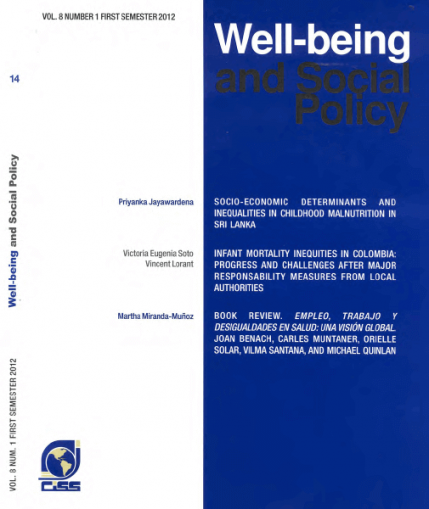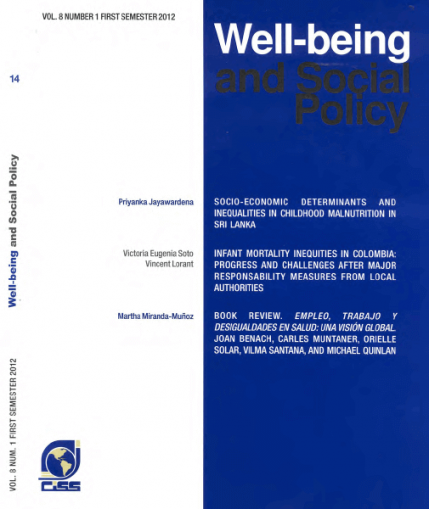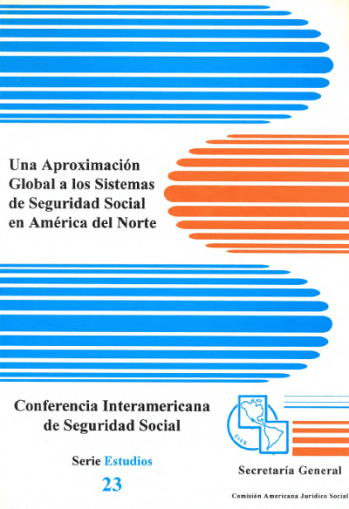|
Limitar tu búsqueda
[+–] Compilador o editor
[+–] Editorial
[+–] Fecha
[+–] Formato
[+–] Idioma
[+–] Tipo de documento
[+–] Tipo de recurso
[+–] Clasificacion
|

|
|
Sinopsis de los sistemas de seguridad social en el Caribe Anglo
Esta publicación plantea una síntesis actualizada de la situación de los seguros sociales en la región del Caribe Anglo bajo la mirada actuarial, a partir del análisis de las relaciones existentes entre pensiones, mercado laboral, demografía, equilibrio macro-económico y crisis económica. El resultado es una cartografía del contexto socioeconómico-demográfico del Caribe y de sus instituciones de...
|

|
|
|
|

|
|
Social capital in labor market access and poverty in Mexico
Social capital, defined as the set of social networks that a person has in order to obtain benefits, is used by the population as a mechanism for providing resources, to cushion shocks in consumption and to obtain information on available employment opportunities. This study employs a logistic model to characterize the manner in which people access the labor market in Mexico through the use of...
|

|
|
|
|

|
|
Socio-economic determinants and inequalities in childhood malnutrition in Sri Lanka
Despite countless initiatives to alleviate malnutrition over the years, it affects hundreds of thousands of children in Sri Lanka. Understanding the determinants of malnutrition and their contribution to socio-economic inequality in malnutrition is essential in targeting specific socio-economic groups to improve their nutrition levels. This study attempts to identify the socio-economic...
|

|
|
|
|

|
|
Infantil mortality inequities in Colombia: Progress and challenges after major responsability measures from local authorities
This paper aims to analyse the space and time distribution of the infant mortality rate (IMR) at municipality level in Colombia before and after conferring greater responsibilities to the municipalities for the administration of the local health care systems. Using special econometrics, we find that there is a geographical concentration of IMR persisting over time and defining two groups of...
|

|
|
|
|

|
|
Book review. Empleo, trabajo y desigualdades en salud: una visión global. Joan Benach, Charles Muntaner, Orielle Solar, Vilma Santana y Michael Quinlan
This is a stimulating book which explores the relationship between employment conditions and health outcomes. The authors provide a conceptual framework to illustrate the channels through which health outcomes are determined and affected; this framework includes individual and aggregate variables, such as the economic, political and environmental conditions. The book also includes case studies...
|

|
|
|
|

|
|
Introduction (On the issues addressed by this issue of the journal)
Micro and small-sized enterprises (MSE) have a central role in economic development in Latin America given their large contribution to employment generation, their share in the total number of firms and, to a lesser extent, their contribution to gross domestic product. Yet, their production is mainly oriented to the domestic market and they are characterized by an increasing productivity gap with...
|

|
|
|
|

|
|
Analysis of the use of financial services by companies in Mexico: What does the 2009 Economic Census tell us?
We present a descriptive analysis of the results of Mexico's 2009 Economic Census regarding the use of bank credit and accounts by productive entities (companies). INEGI was requested to prepare a set of statistics regarding various company characteristics that are relevant to the decisions made by institutions offering banking services. Information was grouped according to company size and to...
|

|
|
|
|

|
|
MSMES in Costa Rica: Chronicle of their poor integration in times of accelerated international integration
El presente documento, está centrado en las Mipyme y en las políticas públicas para su fomento en la economía costarricense. El análisis, se hace a partir de un enfoque alternativo de clasificación de las actividades económicas, el cual permite precisar con mayor detalle las desigualdades entre las actividades tradicionales de amplia trayectoria en la economía, de aquellas actividades que han...
|

|
|
|
|

|
|
Introduction (On the issue of social capital that is addressed in this issue of the journal)
In recent decades, interest has increased in identifying, estimating and linking social capital to a variety of well-being variables in which the production of certain benefits or performance is key. Research has involved the confluence of several disciplines: economics, sociology, anthropology and psychology, to name a few. Although consensus on the definition of a single indicator for measuring...
|

|
|
|
|

|
|
A quantitative analysis of social capital in Mexico
Se ha relacionado el capital social a la eficiencia en los mercados (Arrow, 1972), al refuerzo del contrato (Durlauf y Fafchamps, 2004) y en general al desarrollo y bienestar (Keefer y Knack 1997; Putnam 2000; Knack y Zak 2003). En el presente trabajo hemos investigado los determinantes del capital social empíricamente, centrándose en tres medidas comunes aproximadas de este: dos ligadas a la...
|

|
|
|
|

|
|
Relationship between social capital and health indicators in Mexico
This study analyzes the relationship between social capital types and access to health services in Mexico. To this end, access to healthcare data from the 2006 ENCASU and 2011 ENCAS was validated using 2006 and 2012 ENSANU results. Indicators were found to be consistent. A statistical analysis of the distribution of social capital and health indicators by region, as well as by rural or urban area...
|

|
|
|
|

|
|
The effect of the perception of violence on social capital in Mexico
Increasing levels of violence in Mexico, which have the potential to damage the very fabric of 1 society, as well as impact key economic variables, led us to analyze the effect that changes in the perception of violence had on social capital fluctuations (including associative capital) between 2006 and 2011. This was a period in which an anti-violence and anti-organized crime policy was launched...
|

|
|
|
|

|
|
Promised and actual benefits in mexican social security fot rhe transtion generation
Este artículo presenta un conjunto de mediciones de los costos y beneficios reales del plan general de retiro por jubilación proporcionado a los ciudadanos por parte del Sistema Mexicano de Pensiones (SMP), que son necesarias para evaluar las decisiones de los trabajadores en cuanto a la contribución a la seguridad social (es decir, trabajar en el sector formal) y al retiro. El SMP ofrece dos...
|

|
|
|
|

|
|
Organizations and social capital
An organization is a group of persons who satisfy established membership requirement and whose form and function are generally acknowledged. An organization's membership requirements may be based on inherited or earned traits. Organizations exist because they provide a setting in which members with similar traits can meet their physical and their socioemotional needs. As the relative importance...
|

|
|
|
|

|
|
Do investments in public spaces generate social capital? Evidence for Mexico
The formation of social capital is critical for developing countries. This paper investigates the effects of attempts to recover public spaces in marginalized areas of Mexico. The effects are estimated through balancing in the propensity scores. We focus on the results of perception of safety, support and social capital. When efforts are made to recover public spaces, the perception of safety...
|

|
|
|
|

|
|
Public spaces in Mexico as social cohesion promoters: an structural modeling perspective
This research assessed the effects of several contextual factors (e.g, neighborhood insecurity, evaluation of public spaces, infrastructure, low risk behaviors) on social cohesion and residential satisfaction, in the context of low and medium-low socio economic status of individuals nearby renovated public spaces (parks and recreational facilities) in Mexico. The research method is based on...
|

|
|
|
|

|
|
Principios de la seguridad social americana. Declaración de México
Contenido: Declaración de México. Comentarios: Benito Coquet. Antonio Zelenka. Beryl Frank. Gonzalo Arroba. Integración de las Delegaciones. Firmas.
|

|
|
|
|

|
|
A demographic and economic model of the Canada Pension Plan
This book describes how demographic developments influence the Canadian Social Security System, not only through the evolution of the size and age structure of the Canadian population, but also through the possible economic consequences of a decreasing and ageing population. The second chapter will situate the reader in the historical context of social security systems in the world, it also...
|

|
|
|
|

|
|
Modelo demográfico y económico del Plan de Pensiones de Canadá
El libro describe ampliamente no sólo la forma en la que los fenómenos demográficos influyen en el Sistema de Seguridad Social Canadiense, por la evolución del tamaño y de la estructura por edades de la población canadiense, sino que señala también las posibles consecuencias económicas de una población decreciente yen proceso de envejecimiento.
El segundo capítulo ubica al lector en el...
|

|
|
|
|

|
|
Una aproximación global a los sistemas de seguridad social en América del Norte
Tratando de hacer una aproximación global, tal y como lo indica el título, el trabajo se compone de tres partes básicas. La primera parte aborda los orígenes de cada uno de los sistemas de seguridad social en América del Norte: en Estados Unidos, en Canadá y en México, orígenes que van no sólo a marcar, sino a determinar la evolución futura de los sistemas en lo social, lo político y lo...
|

|
|
|
|
|